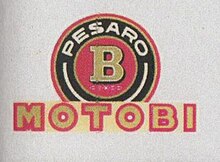
Aprilia is an Italian motorcycle manufacturer founded immediately after World War II in Noale, Italy, by Alberto Beggio. The company started as a manufacturer of bicycles and moved on to manufacture scooters and small-capacity motorcycles. Since in the 1980s, Aprilia has also produced large sportbikes such as the 1,000 cc V-twin RSV Mille and the V4 RSV4.

Motorenwerke Zschopau GmbH is a German motorcycle manufacturer located in Zschopau, Saxony. The acronym MZ since 1956 stands for Motorenwerke Zschopau GmbH. From 1992 to 1999 the company was called MuZ, an acronym for Motorrad und Zweiradwerk.

KTM is an Austrian motorcycle, bicycle and motorsports brand which is co-owned by Indian manufacturer Bajaj Auto and Austrian manufacturer Pierer Mobility AG. It traces its foundation to 1934 as Kronreif & Trunkenpolz Mattighofen. Today, Pierer Mobility AG operates as the manufacturer of KTM branded motorcycles, and KTM Fahrrad AG operates as the manufacturer of KTM branded bicycles.

Benelli Q.J. is an Italian company, based in the city of Pesaro in the Marche region, that produces motorcycles and scooters.

Moto Guzzi is an Italian motorcycle manufacturer and the oldest European manufacturer in continuous motorcycle production.

Gilera is an Italian motorcycle manufacturer founded in Arcore in 1909 by Giuseppe Gilera (1887–1971). In 1969, the company was purchased by Piaggio.

The Moto Rumi organisation was formed at the beginning of the twentieth century and originally supplied cast components to the textile machinery industry. At the outbreak of World War II, Rumi became involved in the manufacture of armaments, miniature submarines and torpedoes. After the end of the war in 1950, Rumi decided to get involved in the manufacture of lightweight motorcycles. It was also decided to base the powerplant on the horizontal twin two stroke unit of 125 cc capacity.

A motorcycle engine is an engine that powers a motorcycle. Motorcycle engines are typically two-stroke or four-stroke internal combustion engines, but other engine types, such as Wankels and electric motors, have been used.

Renzo Pasolini, nicknamed "Paso", was an Italian professional motorcycle road racer. He competed in the FIM Grand Prix motorcycle racing world championships from 1964 to 1972.

The Ducati singles were single cylinder motorcycles, made by Ducati from 1950 to 1974. Chief Engineer Fabio Taglioni developed a desmodromic valve system in these years, a system that opens and closes the valves using the camshaft, without the need for valve springs. This valve system has become a trademark feature of Ducati motorcycles.

Walter Villa was an Italian four-time Grand Prix motorcycle road racing world champion. He was known for his quiet, unassuming nature off the bike who became a ruthless competitor once the races began.
MBP Morbidelli was an Italian motorcycle manufacturer founded by Giancarlo Morbidelli in Pesaro. During the late 1970s and early 1980s, the company was particularly successful in Grand Prix motorcycle racing. The team won the 125 cc world championship in 1975, 1976 and 1977, and won the 250 cc championship in 1977.
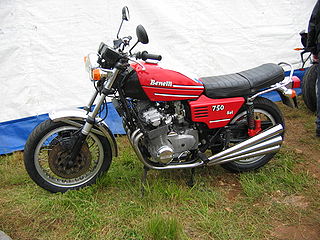
The Benelli Sei is a series of motorcycles that were produced by Italian manufacturer Benelli, and masterminded by automotive designer Alejandro de Tomaso, from 1973 to 1989. Two models were made, with 750 and 900 cc displacement. The 750 was the first production motorcycle with a six-cylinder engine.
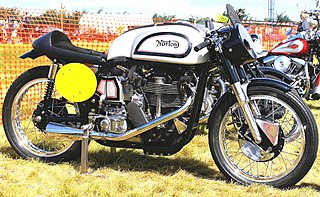
The Norton Manx or Manx Norton is a British racing motorcycle that was made from 1947 to 1962 by Norton Motors Ltd. Norton had contested every Isle of Man TT race from the inaugural 1907 event through into the 1970s, a feat unrivalled by any other manufacturer, and the development and honing of the Manx racing motorcycle was another step in this racing achievement.
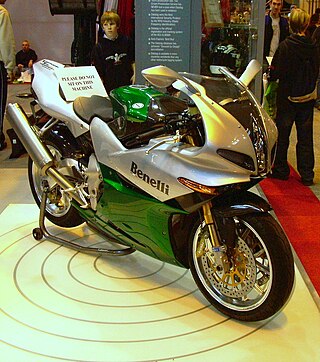
The Benelli Tornado Tre 900 is a motorcycle made from 2002 to 2014 by Benelli of Pesaro, Italy. The last model was designated as the Tornado Tre 903.
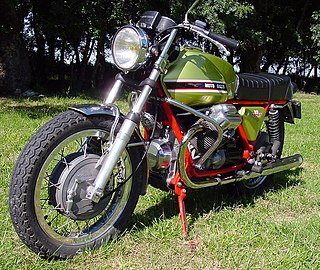
Lino Tonti was an Italian motorcycle engineer known for designing a number of sport and racing motorcycles in the 1950s and 1960s, and for creating his signature 'Tonti frame' for Moto Guzzi's 1971 V7 Sport, setting his stamp on all Moto Guzzis since.

Qianjiang Motorcycle Group, doing business as QJMotor, is a Chinese motorcycle manufacturer founded in 1985 and headquartered in Winling, Zhejiang Province. It is one of the largest two-wheeled vehicle manufacturers in China.
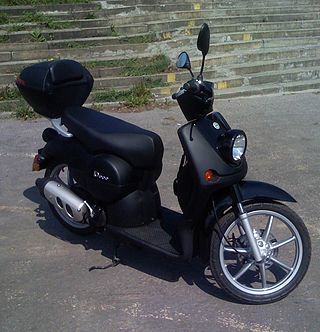
The Benelli Pepe is a scooter produced from 1998 to 2015 by the Italian motorcycle manufacturer Benelli.

The Benelli 650 Tornado is a 650 cc (40 cu in) parallel twin motorcycle produced by the Italian manufacturer Benelli from 1970 to 1975. The model was intended to compete with the British big twins in the lucrative American Market but by the time the model was introduced the market had changed following the launch of multi-cylinder bikes by the Japanese manufacturers, most notably the Honda CB750. The Tornado was also badge engineered as a Motobi, Benelli's sister company. Around 3,000 Tornados were produced with half being sold in Italy.
